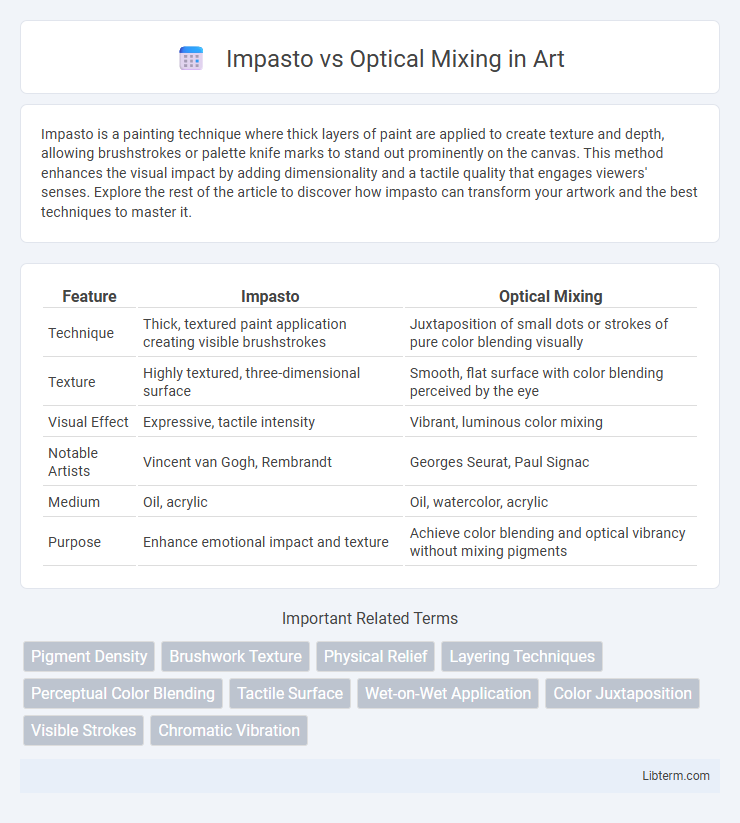Impasto is a painting technique where thick layers of paint are applied to create texture and depth, allowing brushstrokes or palette knife marks to stand out prominently on the canvas. This method enhances the visual impact by adding dimensionality and a tactile quality that engages viewers' senses. Explore the rest of the article to discover how impasto can transform your artwork and the best techniques to master it.
Table of Comparison
| Feature | Impasto | Optical Mixing |
|---|---|---|
| Technique | Thick, textured paint application creating visible brushstrokes | Juxtaposition of small dots or strokes of pure color blending visually |
| Texture | Highly textured, three-dimensional surface | Smooth, flat surface with color blending perceived by the eye |
| Visual Effect | Expressive, tactile intensity | Vibrant, luminous color mixing |
| Notable Artists | Vincent van Gogh, Rembrandt | Georges Seurat, Paul Signac |
| Medium | Oil, acrylic | Oil, watercolor, acrylic |
| Purpose | Enhance emotional impact and texture | Achieve color blending and optical vibrancy without mixing pigments |
Introduction to Impasto and Optical Mixing
Impasto is a painting technique characterized by thick, textured layers of paint that create a three-dimensional surface, enhancing the tactile experience and visual depth. Optical mixing occurs when small, distinct dots or strokes of pure color are applied close together, allowing the viewer's eye to blend them at a distance, producing vibrant color effects without physically mixing the pigments. Both methods influence color perception, with impasto emphasizing texture and physicality, while optical mixing relies on visual interaction and color theory principles.
Defining Impasto Technique
Impasto technique involves applying thick layers of paint to create texture and depth, allowing brushstrokes or palette knife marks to remain visible on the canvas. This method contrasts with optical mixing, where colors are placed as small dots or strokes that visually blend when viewed from a distance. Impasto emphasizes tactile surface quality, enhancing the three-dimensional effect and emotional intensity of the artwork.
Understanding Optical Mixing in Art
Optical mixing in art refers to the technique where distinct colors are placed closely together, allowing the viewer's eye to blend them into a single, harmonious hue from a distance. This method relies on the principles of color theory and human perception, creating vibrant effects without physically mixing pigments on the palette. Unlike impasto, which emphasizes texture and thick layers of paint, optical mixing focuses on visual color interaction to achieve luminosity and depth on a flat surface.
Historical Origins and Evolution
Impasto, originating in the Renaissance with artists like Titian, emphasizes thick, textured paint application to create dimensionality and expressive brushstrokes. Optical mixing, developed in the late 19th century by Impressionists such as Georges Seurat, relies on placing small dots or strokes of pure color that the viewer's eye blends at a distance to achieve vivid color effects. Both techniques evolved through experimentation with light and texture, influencing modern art movements that explore perceptual color theory and tactile surfaces.
Key Artists and Iconic Works
Impasto technique, characterized by thick, textured paint application, is famously exemplified by Vincent van Gogh's "Starry Night," where heavy brushstrokes create dynamic surface depth. Optical mixing, utilized by Georges Seurat in "A Sunday Afternoon on the Island of La Grande Jatte," relies on placing individual dots of color that visually blend at a distance. Key artists associated with impasto include Rembrandt and Jackson Pollock, while optical mixing is primarily linked to Seurat and Paul Signac.
Materials and Tools Used
Impasto technique involves applying thick layers of paint using palette knives or stiff brushes, emphasizing texture and volume with heavy-bodied acrylics or oil paints. Optical mixing relies on fine dots or strokes of pure pigment applied with fine brushes or sponges, predominantly using watercolors or acrylics to blend colors visually from a distance. Artists select impasto for tactile texture effects and optical mixing for vibrant color interactions without physical texture.
Visual Effects and Surface Texture
Impasto creates a tactile surface texture with thick, layered paint that enhances light reflection and shadows, resulting in a dynamic, three-dimensional visual effect. Optical mixing relies on placing small, distinct color dots or strokes side by side, allowing the viewer's eye to blend hues from a distance, producing vibrant color vibrancy and luminosity without physical texture. The impasto technique emphasizes physical depth and texture, while optical mixing achieves visual complexity through color interaction and perceptual blending.
Application Methods Compared
Impasto technique involves applying thick layers of paint with a palette knife or brush to create texture and depth on the canvas, allowing light to interact with the raised paint surface for a tactile visual effect. Optical mixing relies on placing small, distinct dots or strokes of pure color closely together, enabling the viewer's eye to blend them from a distance into a smooth gradation or new color without physical mixing. While impasto emphasizes physical texture and three-dimensionality, optical mixing prioritizes color theory and visual perception for creating vibrant and dynamic compositions.
Impact on Viewer Perception
Impasto creates tactile, three-dimensional textures that engage viewers through physical depth and light reflection, enhancing emotional intensity and visual drama. Optical mixing relies on the viewer's eye to blend small, distinct color patches from a distance, producing vibrant color effects and dynamic color interactions without physical texture. The contrasting sensory experiences of impasto's tangible surface and optical mixing's visual color fusion significantly affect how viewers perceive movement, depth, and emotional resonance in a painting.
Choosing the Right Technique for Your Art
Impasto technique enhances texture and depth by applying thick layers of paint that capture light and create tactile interest, ideal for artists seeking bold, expressive effects. Optical mixing relies on placing small, distinct color strokes close together so the viewer's eye blends them from a distance, perfect for achieving vibrant luminosity and subtle color transitions. Selecting the right technique depends on the desired visual impact, surface texture, and the artist's expressive intent within the artwork.
Impasto Infographic

 libterm.com
libterm.com